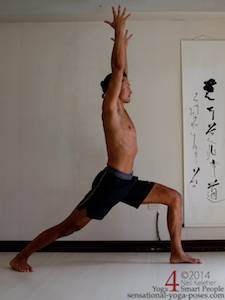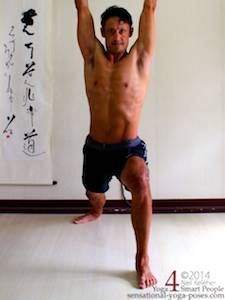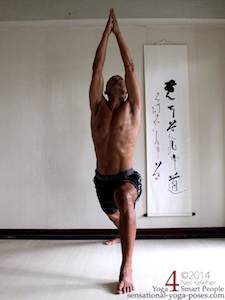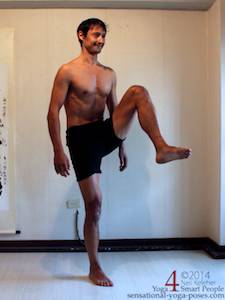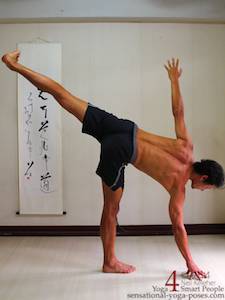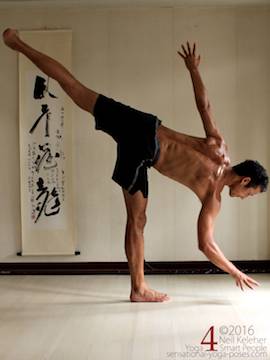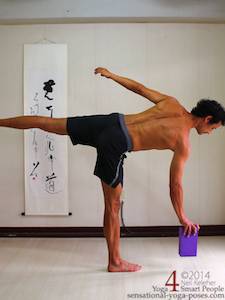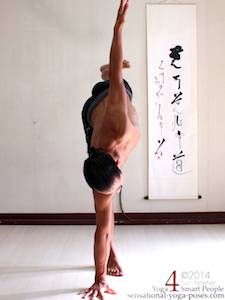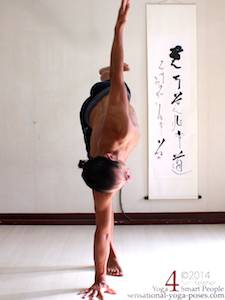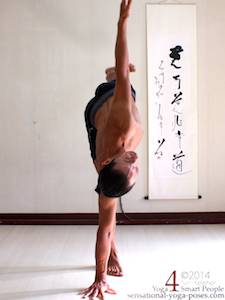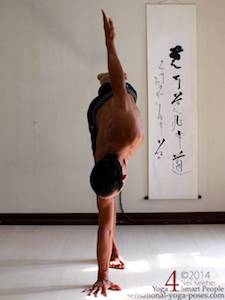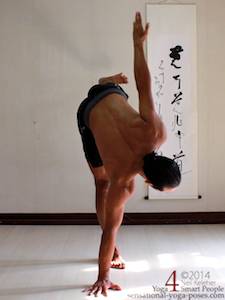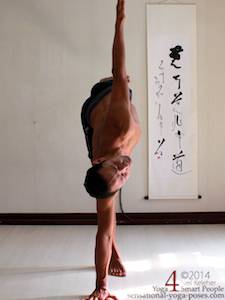Related:
Naturally Stable Yoga Poses
Standing on both feet with the feet widely separated we don't have to think too much about stability because our stance is naturally stable.
As an example, standing in Warrior 1 the pose is naturally stable from front to back because the feet span a large distance making it very easy to keep our center of gravity over our foundation from front to back.
Standing with the feet wide from side to side also makes the pose stable from left to right.
Generally when working with beginners, I tend to teach a wider stance so that it is easier to focus on lengthening and then relaxing the spine.
However, if I wanted to use this pose to work on lateral balance and stability then I would have them stand with the feet forming a narrower base from side to side. The feet and ankles then have to be more active to stay balanced.
In this case the muscles of the feet and ankles work against each other and the ground to create stability. The more force these muscles exert force against each other and the ground then the stiffer and more stable the feet and ankles.
This is one way of thinking about stability.
Stability via Sensitivity (and Responsiveness)
A more refined stabilizing method is to use the feet to feel when we are going off balance. The feet and ankles can then be used to keep us balanced only when we are moving away from balance.
Some tension is required to press the feet into the floor so that they can then be used as sensors. This same tension then enables us to use the feet easily, when required to stay balanced.
In Warrior 1 because the stance is long from front to back we don't have to worry too much about front to back movements, instead we can be on the lookout for side to side movements since these are the ones that can throw us of balance.
When using sensitivity and responsiveness to create stability on demand, it is important to be able to detect changes as early as possible. The early changes are detected, the sooner appropriate responses can be made to counter those changes.
The earlier we sense perturbations the easier it is to stay balanced.
There are a number of ways to sense perturbations or change.
Look to the Horizon (Effective Sensitivity and Responsiveness)
Driving a car or motorbike a technique for sensing changes as early as possible uses the eyes to "Look to the Horizon."
Although this technique is called "Looking to the Horizon" it actually involves seeing (or sensing) everything on the road between ourselves and the horizon.
Generally when driving I try to see all of the road between me and the road's horizon. If the road has a dip in it and what is in that dip is invisible, then the horizon extends only to the edge of the dip even if I can see the road after the dip.
The horizon I am concerned with contains anything that I can respond to now. If I sense something in my lane between me and the horizon then I can change lanes, slow down or speed up or take whatever steps are necessary.
And if I sense this as early as possible, the sooner I can respond and with the least effort possible.
Another important point when driving is that the horizon is always shifting. Sometimes it's closer, sometimes further. The important thing is to be aware of it and everything on the road between us and it.
With yoga the horizon includes all of our body and it's connection to the earth or any other body. Rather than using our eyes, we can use other sensing methods, learning to feel pressure at our point of contact with the earth or learning to create and feel tension within our body.
Tension For Information and Minimizing Wobble
I tend to talk about "feeling" pressure changes with respect to balance but it can be important even in poses where balance isn't critical. Noticing changes in pressure, we can feel when our body is moving away from balance. Or we can feel where our center of gravity is with respect to our foundation.
Tension is another means of sensing change (and creating it) within our body. The ideal is to create enough tension that we can easily feel our body and control it. Changes in tension then tell us when our body is moving or changing. The challenge for beginners is to learn how to create this tension (and how to interpret the data it gives us.)
A very simple tensioning mechanism is to create space within the body.
A primary example is lifting and expanding the ribcage to add tension to the waist and to the tissue that spans the intercostal spaces (the spaces between the ribs).
This can give us a feel for our waist and ribcage and, while doing a twist for example, we can make adjustments to the ribcage to maximize the twist, reducing excess tension and adding tension or "feel" where there is none.
An advantage of tension is that not only does it give us information it also helps us to maintain the shape we are in.
Another word for "change" is information. Changes in tension give us information that something has happened..
Whether holding a yoga pose, or moving, in either case when we sense changes we can respond in such a way that we can continue to hold the pose with minimal perturbation to the pose or we can continue to do the movement with minimum ill effect on the movement.
We can continue to do what we are doing with minimum wobble.
And so one key to stability in yoga poses (and movement) isn't maximizing stiffness. It's maximizing the ability to process information from our body so that we know what's happening and it's the ability to respond to that information in such a way that we can continue to do what we are doing.
Creating Stability when Balanced On One Leg
As mentioned, some poses are naturally stable. As a result we can afford to pay less attention to stability. How might we stabilize the body in a pose where inherent stability is a little less?
When standing on one foot stability can be a bit more challenging.
The foot can change shape in such a way that the shin rotates.
The pelvis can sag and rotate and tip. And while it is possible to balance with foot and hip relaxed it can be harder to doing anything meaningful with the rest of the body.
In the past I've focused on foot stability first, shaping the foot for a "stiffer" but still controllable foot. By stabilizing the foot and ankle, the muscles that cross the knee have a base from which to stabilize the thigh which in turn can then be used as a base for stabilizing the pelvis.
My current approach involves stabilizing the hip, stabilizing the thigh relative to the pelvis. Muscles that cross the knee can then be used to stabilize the lower leg and then in turn the muscles that act on the ankle and foot then have a stable base from which to stabilize the foot and ankle.
(Even now, as I re-read and re-write this article, I'm experimenting with knee stability in yoga poses.)
When standing on one foot I think the quality to be most aware of is leg rotation since too much external rotation makes it harder to keep the base of the big toe in contact with the floor. Too much internal rotation can lead to the arch collapsing. And so one possible ideal is to maintain just enough rotation to keep the arch lifted but not so much that the root of the big toe loses contact with the floor.
We can then use the foot as both a sensor and a stabilizer when required.
Now while it could be simple to say "for maximum stability make the hip as tight as possible" this then comes at a cost of reduced sensitivity and it may also affect controllability.
If we want to move the pelvis (and thus the upper body) relative to the standing leg then too much tension can make this harder too do. With optimum tension, enough to feel the hip joint and control it we can move the pelvis as required.
Advantages of Hip Stability
One advantage of hip stability (along with leg stability) is that it stabilizes the pelvis relative to the leg. Muscles that act on the waist then have a stable foundation from which to work on the ribcage. In addition muscles which act between the leg and spine (psoas, piriformis, gluteus maximus) then have a stable foundation from which to work on the spine.
If we wanted to do something with the non-supporting leg, say lifting it, then the task is then to stabilize the pelvis, lumbar spine and ribcage so that the hip muscles of the lifted leg then have a stable platform to work from.
Connective Tissue Tension
One reason for starting at the hips is that tension in the hip muscles may affect tension in the lower leg muscles via connective tissue tension since muscles of the leg and hip share connective tissue anatomy trains. Hip muscle tension may add a base layer of tension to the connective tissue sheaths of the lower leg muscles meaning that those muscles then don't have to exert so much contractive effort themselves.
The same may be true in reverse though I suspect that the larger muscles of the hip may have a greater effect on connective tissue tension than the smaller muscles of the foot.
Giving Muscles Room to Move
One further idea that can be helpful, especially when it comes to controlling muscle tissue is the idea of "room to move."
The idea is that for a muscle to contract effectively it has a working length. Too short and it makes it harder to contract, too long and again the muscle may have difficulty contracting.
When lifting one leg while standing on the other leg, it can help to not only stabilize the pelvis, waist and ribcage, but also to change their shape as required so that the muscles operating on the leg have room to move.
And so for example, when bringing the knee to the chest I'll often flatten the lumbar spine so that the psoas has more room to contract, and bringing the knee closer to the chest. If I just held the lumbar spine in a fixed position, locked solid, then the psoas would be forced to do a harder contraction.
Creating stability with both sensitivity and control we can make adjustments easier so that we can move deeper into yoga poses without overstressing any one part of the body.
Reducing Wobble with Awareness
Stability is a lack of wobble. Moving further up the body, the less wobble there is in the upper body, including the arms and head, the easier it is to keep our center of gravity over our foundation. The better we are at keeping our center over our foundation the less we have to work to stay balanced,
Half Moon Pose
One of my favorite ways of demonstrating this and practicing it is in half moon pose. The exercise can be to lift and lower the hand.
Lifting the hand in half moon yoga pose.
One technique is to make the foot stable and then lift the hand. Generally the action becomes easier if weight is shifted over the foot first, then make the foot stable and then lift the hand. The more aware the less effort is required to stabilize the foot and lift the hand.
Looking up while keeping the head over the center line of the foundation in half moon yoga pose.
If trying to look up in half moon then we can work to keep the head on an axis so that we keep our weight over our foundation. We then don't have to work too hard to stabilize.
Or we can be aware of the foot in particular so that as we move the head, even if our head moves of the center line then we can still compensate as required.
Moving the head (and torso) off of the center line while looking up,
I can use foot (and hand) awareness to stay balanced.
Basic stability in yoga poses can come from using muscles against each other. Can you adjust the tension till it is minimal so that you use minimal effort to stabilize?
If we can reduce tension to "just enough" so that we can feel our body and respond, we then make it easier to reduce wobbliness without a lot of wasted effort.
Published: 2014 12 27
Updated: 2023 03 22
